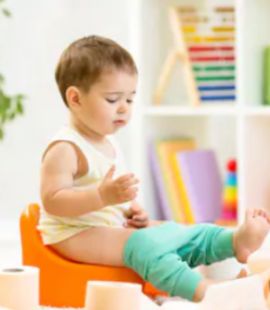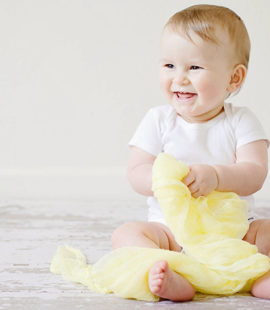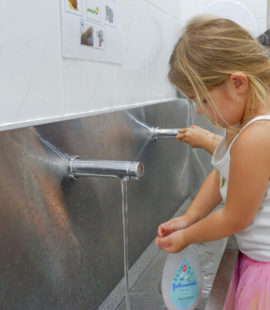Les étapes clés dans l'accompagnement à la propreté
Respecter son rythme
The acquisition of cleanliness requires patience, perseverance and a dose of good humor! In general, a child learns to be clean between 2 and 4 years old, but it is important to respect his pace when he begins this learning.
When is my child ready?
To become clean, a child must first learn to control his sphincters. It is only around the age of about 2 years that the child can recognize the sensation that his organs are « full ». The role of parents is not to « teach » but rather to support and supervise him throughout the toilet training. To use the potty successfully, your child must be ready physiologically and, above all, psychologically. It is therefore important to trust him.
Some signs like:
- He himself goes to his potty and sits on it by himself.
- He partially undresses without your help.
- It stays dry for several hours.
- He tells you when his diaper is dirty (ex: « pee », « poo »).
- He is curious about it (ex: puts his comforter on the potty, likes stories about cleanliness).
6 ÉTAPES CLÉS POUR APPRENDRE À VOTRE ENFANT À ALLER SUR LE POT
1/ Don’t force it
The age of potty training varies from child to child. For this reason, avoid establishing the age at which you consider your child should be potty-trained. Instead, wait for him to show signs that he’s ready, then go with his pace
2/ Choose the right time for your child
There is no ideal time for toilet training, but it is advisable to start during a peaceful period at home (eg: avoid during a move or the arrival of a little brother or a little sister).
3/ Familiarize him with the potty
Place his potty near the toilet and explain to him what it is for. Then, invite him to sit on it, even fully clothed, or to sit his cuddly toy on it. At first it will be a game! Encourage him to follow you when he has to pee or poop. Praise him every time he tries!
4/ Establish a routine
Gradually get your child to sit on the potty at regular times: when waking up, after meals and snacks, and before naps, baths and bedtime, but no more than 5 minutes. Avoid toys or books while he’s sitting on the potty to let him concentrate on feeling his sphincters. If nothing happens, let him go back to playing without showing disappointment or commenting on it.
5/ Passez à la culotte
Si votre enfant commence à utiliser le pot souvent, ne lui mettez plus de couches pendant la journée. Il sera alors plus motivé à rester au sec avec une culotte en tissu ou d’entraînement. Mettez-lui des vêtements faciles à enlever et rappelez-lui souvent d’aller sur le pot. À son âge, c’est normal qu’il oublie de le faire, surtout s’il est concentré à jouer donc ne mettez pas trop d’accent sur les petits accidents mais plutôt augmentez son estime de soi en l’encourageant de nouveau et en lui rappelant ses réussites.
6/ Supprimez complètement la couche
Il reste propre toute la journée et sa couche est sèche pendant plusieurs siestes ? Il est temps de la supprimer. Puis appliquez la même méthode pour la nuit. D’ici là, même si vous lui mettez une couche pour dormir, encouragez-le à vous appeler s’il a envie d’aller sur le pot pendant la sieste ou la nuit.




QUELQUES QUESTIONS DURANT L'APPRENTISSAGE
À RETENIR !
- Pour apprendre à être propre, l’enfant doit être prêt physiologiquement et psychologiquement. Cela se produit en général entre 2 et 4 ans.
- Il ne faut pas forcer un enfant à devenir propre, mais plutôt suivre son rythme et lui faire confiance.
- Si l’enfant fait pipi ou caca dans sa culotte, il ne faut pas le gronder ni le punir. Si cela est nécessaire, il devrait aussi pouvoir recommencer à porter une couche sans éprouver de honte.
Source : Birth and Grow
Scientific review : Dr. Anne-Claude Bernard-Bonnin, pediatrician / Research and writing: Team Birth and Grow







